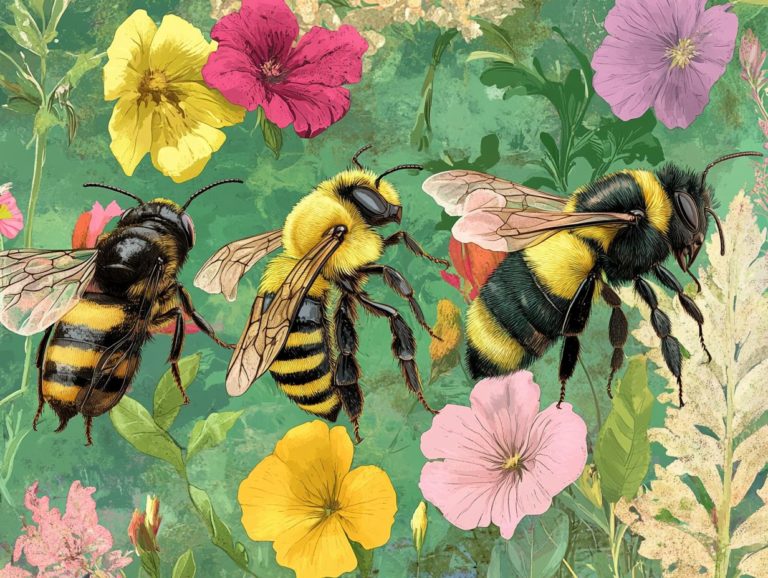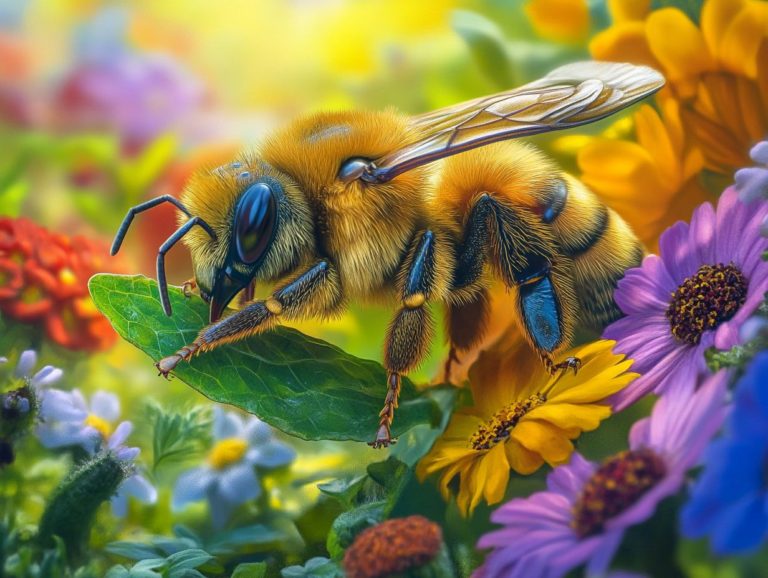How Bees Are Adapting to Urban Environments
Bees, frequently perceived as creatures of the countryside, are vital contributors to urban ecosystems as well. Their indispensable role in pollination nourishes local gardens and urban agriculture while fostering biodiversity within city landscapes.
Urban environments present distinct challenges for these hardworking insects, ranging from habitat loss due to urbanization to exposure to pesticides. Remarkably, bees are finding ways to adapt to these urban shifts, showcasing their resilience.
This article delves into the importance of bees in urban settings and emphasizes how you can play a role in ensuring their flourishing presence in our cities, such as supporting bee-friendly design and participating in awareness programs.
Contents
- Key Takeaways:
- Why are Bees Important for Urban Environments?
- Challenges Faced by Bees in Urban Environments
- How Are Bees Adapting to Urban Environments?
- Benefits of Bees Adapting to Urban Environments and Urban Agriculture
- What Can We Do to Help Bees Thrive in Urban Environments?
- Frequently Asked Questions
- How are bees adapting to urban environments?
- What changes have bees made in their foraging habits in urban environments?
- Why are bees building nests in new locations in urban areas?
- How are bees developing resistance to pesticides and pollutants in urban environments?
- Are there any negative impacts of bees adapting to urban environments?
- What can individuals do to help bees adapt to urban environments?
Key Takeaways:
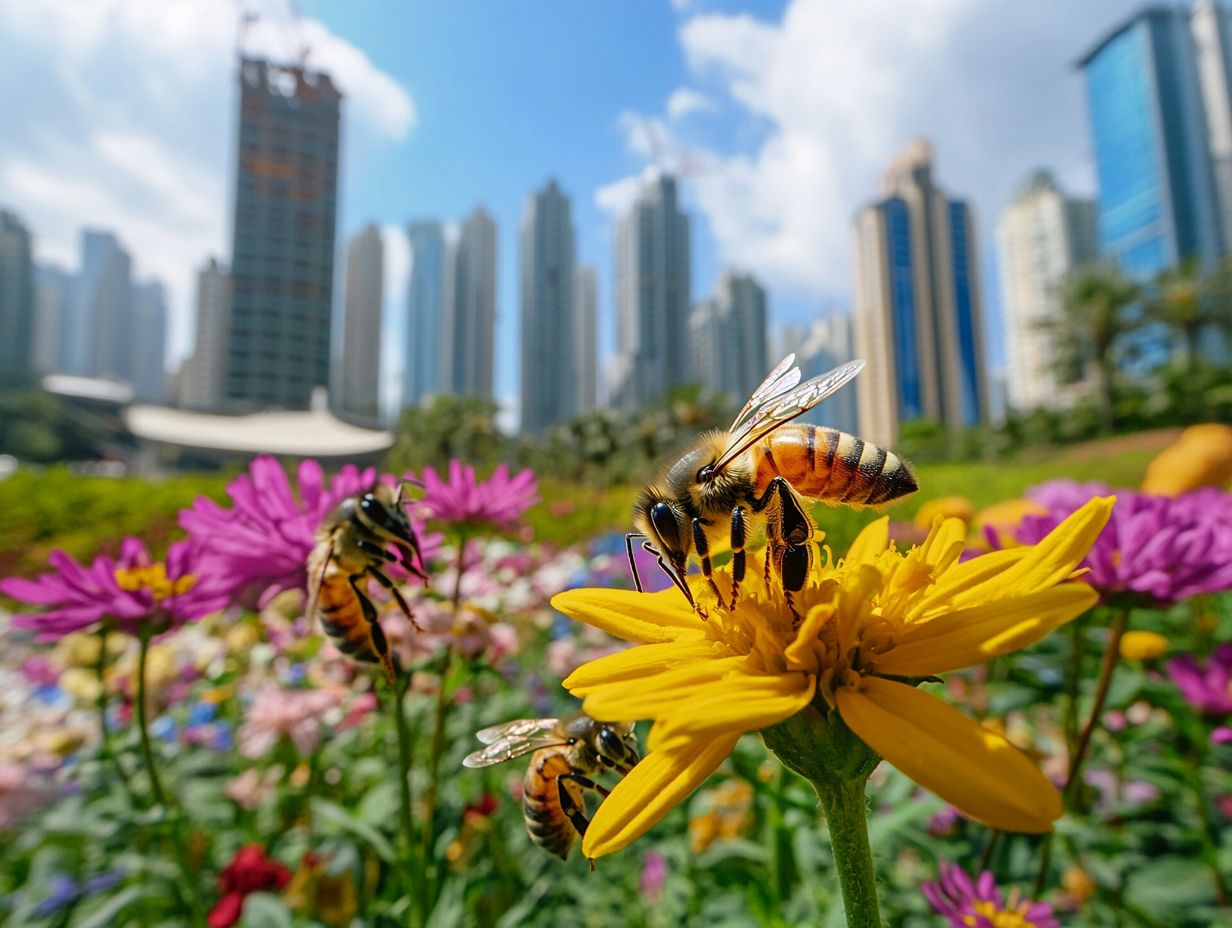
- Bees play a crucial role in pollination, benefiting urban gardens and farms and increasing crop production, which contributes to food security.
- Bees face challenges such as loss of habitat, exposure to pesticides, environmental toxins, and competition with non-native and invasive species in urban environments.
- Bees are adapting to urban environments by changing nesting behaviors, foraging patterns, and developing resistance to pesticides, demonstrating their resilience amidst climate change impacts.
Why are Bees Important for Urban Environments?
Bees are critical allies in urban environments, offering vital pollination services that bolster biodiversity and enhance the functionality of city ecosystems.
As urbanization continues to rise, the well-being of bee populations directly impacts your urban gardens, local food supply, and the overall health of the environment in your community.
In the absence of diverse pollinator habitats, you risk facing significant challenges to floral diversity, food security, community cohesion, and overall environmental health.
It s crucial to cultivate an appreciation for the intricate ecological roles that bees fulfill in residential areas, public parks, and city parks, ensuring a thriving urban ecosystem for all.
What Role Do Bees Play in Pollination?
Bees, especially species like Apis mellifera, play a crucial role as pollinators, facilitating the essential process of pollination that is vital for the reproduction of numerous flowering plants and the production of local fruits. By transferring pollen, they not only promote the growth of diverse plant species but also directly influence the availability of sustainable honey and agricultural outputs in urban areas.
Through their diligent foraging behaviors, bees gather nectar and pollen, which are critical food sources for their hives. This mutualistic relationship between bees and flowering plants not only enhances biodiversity but also stabilizes ecosystems. As they flit from bloom to bloom in search of nectar, they inadvertently transfer pollen grains that are essential for fertilization and seed production, enriching both urban gardens and crop fields.
The decline of bee populations poses a significant threat to these processes, resulting in decreased yields and reduced floral diversity. Thus, grasping the intricate mechanics of pollination underscores the necessity of conservation efforts for these invaluable insects, which include habitat restoration and the promotion of native trees and plants.
How Do Bees Benefit Urban Gardens and Farms?
You ll discover that bees play an invaluable role in urban gardens and farms by enhancing pollination, leading to increased yields of local fruits and vegetables. This boost significantly contributes to food security in cities.
The presence of these industrious insects not only promotes greater biodiversity but also encourages the cultivation of honey-based products, fostering economic growth and community engagement, including through beekeepers and community gardens.
These small yet vital creatures are essential in creating a balanced ecosystem, supporting not just the plants but also the wider agricultural community. As they flit from flower to flower, bees help produce not only more abundant crops but also enhanced varieties that attract local consumers. This increased biodiversity is crucial for the resilience of urban gardens, ensuring they stand strong against pests and disease.
As a result, community gardens flourish, and local economies thrive from the sale of fresh produce and artisanal honey. This dynamic interplay between ecological health and economic vitality in urban settings is a testament to the significance of bees in our lives.
Challenges Faced by Bees in Urban Environments
Bees face many challenges in cities that threaten their health and populations because of habitat loss and urbanization. As cities expand, the natural spaces that bees rely on are increasingly replaced by concrete structures, leading to a significant decline in floral diversity essential for their survival.
Furthermore, exposure to environmental toxins, such as pesticides and pollutants, intensifies these challenges. We must tackle these challenges to protect bee species and their vital roles in our ecosystems.
Loss of Habitat and Food Sources
Urbanization threatens bee habitats and food sources. The natural environments where bees thrive are increasingly replaced by urban structures, severely restricting the availability of native trees and wildflowers that provide nourishment to bees.
You can help restore green spaces vital for their survival. As cities continue to grow, the removal of these essential plants contributes to a notable decline in pollinator populations.
Without access to diverse ecosystems, bees struggle to find the variety of sugary liquids that flowers produce and pollen they need throughout the changing seasons.
To combat this decline, encourage urban planners and communities to embrace initiatives that enhance floral diversity. By incorporating native plants in parks, gardens, and along streets, while promoting sustainable landscaping practices, we can create a more inviting environment for bees.
Education campaigns and volunteer groups can engage local residents in planting bee-friendly flowers, fostering appreciation for biodiversity and playing a crucial role in ensuring the survival of these essential pollinators.
Exposure to Pesticides and Pollution

Pesticides and pollution harm bee health and reduce biodiversity. The use of chemical pesticides not only directly harms bee populations but also disrupts the ecological balance essential for vibrant urban ecosystems.
As these vital pollinators face mounting threats, the intricate web of life that supports our urban gardens, parks, and green spaces is at risk. Declining bee populations don t just affect the plants that rely on them for pollination; they also undermine food sources for other wildlife, triggering a cascade of negative effects across urban habitats.
Embracing sustainable practices, such as organic gardening and minimizing pesticide usage, is crucial for creating environments where bees can thrive. By acknowledging the profound impact of pesticide use on these essential creatures, we can work collaboratively to restore balance and promote urban biodiversity.
Together, we can protect our ecosystems for future generations.
Competition with Non-Native Species
Non-native species threaten native bees in urban environments. These invaders often outcompete local bees for essential resources, leading to significant declines in local pollinator habitats. This competition diminishes the diversity of bee species and undermines the overall resilience of urban ecosystems.
When non-native plants and animals enter the scene, they disrupt the delicate balance of native ecosystems, making it increasingly difficult for native bees to flourish. These invasive species frequently monopolize flowering plants, which are crucial for bees food sources, reducing the availability of nectar and pollen.
Consequently, bee populations may suffer from starvation and decreased reproductive success. This competition harms not only bees but also other pollinators, threatening our urban ecosystems.
The erosion of diverse pollinator communities poses a serious threat to the successful pollination of numerous plants, vital for sustaining healthy ecosystems and food sources within urban landscapes.
Join local initiatives aimed at preserving and enhancing bee habitats to support these essential pollinators.
How Are Bees Adapting to Urban Environments?
Bees are showing a strong ability to adapt to urban environments, using various strategies to navigate the unique challenges they face, such as the urban heat island effect. This phenomenon occurs when urban areas become significantly warmer than their rural surroundings due to human activities.
Shifts in their nesting behaviors and foraging patterns have emerged as critical adaptations, enabling them to thrive in the complexities of urban life. For instance, the use of bee boxes has become commonplace.
Certain bee populations are evolving resistance to pesticides, showcasing their remarkable resilience against environmental stressors, as highlighted in studies presented at COP27.
Changes in Nesting Behaviors
In urban settings, bees are evolving their nesting behaviors to adapt to the challenges posed by urbanization. These industrious creatures are choosing less conventional nesting sites in urban gardens that are more accessible, demonstrating their resourcefulness in a rapidly changing landscape.
For example, many urban bee species, including Apis mellifera (honey bees), have been observed utilizing crevices in brick walls, hollow stems in gardens, and even repurposing abandoned structures for their nests. These adaptations provide shelter and significantly enhance their survival odds by keeping them near diverse foraging resources.
The availability of food sources, such as flowering plants in community gardens and city parks, is crucial for sustaining their populations. These unconventional nesting strategies can lead to greater reproductive success, as bees thrive in environments with less competition.
This remarkable flexibility in nesting behaviors highlights the resilience of urban bee species as they navigate the complexities of city life.
Shifts in Foraging Patterns and Bee Species
Shifts in foraging patterns are a key adaptation observed in urban bees, driven by the availability of floral diversity and nectar sources in city landscapes. These bees are increasingly relying on specific flowering plants that thrive in urban settings, adjusting their foraging routes to optimize their nectar collection and enhance pollination services.
This adaptation reflects the evolving dynamics of urban environments and shows how these remarkable pollinators respond to changes in floral availability throughout the seasons. In cities with a mix of gardens, parks, and green roofs, the variety and timing of blooming plants play a vital role in shaping the foraging strategies that bees employ.
Such shifts can directly impact their health, as a more varied diet supports better nutrition and stronger immune responses. Understanding these foraging adaptations is essential for promoting urban biodiversity and ensuring these vital pollinators continue to deliver critical ecosystem services, which contribute to environmental health.
Development of Resistance to Pesticides and Climate Change
The emergence of pesticide resistance in certain bee populations underscores their resilience in urban environments. This ability allows them not just to survive but thrive despite the widespread use of chemical treatments that threaten their health.
Researchers observe that this resistance arises from a combination of genetic modifications and behavioral changes in urban bees. Genetic adaptations may allow some bees to metabolize toxins more effectively or repair cellular damage from pesticide exposure.
Additionally, behavioral shifts such as altered foraging patterns and changes in hive dynamics are crucial for their survival. Beekeepers play an essential role in maintaining healthy colonies and promoting sustainable practices to support these adaptations.
These mechanisms not only affect the survival of bee populations but also have significant implications for urban ecosystem health. As essential pollinators, their adaptations influence plant reproduction, biodiversity, and the overall ecological balance in urban settings, where species interactions are often disrupted by human activity and climate change.
Benefits of Bees Adapting to Urban Environments and Urban Agriculture
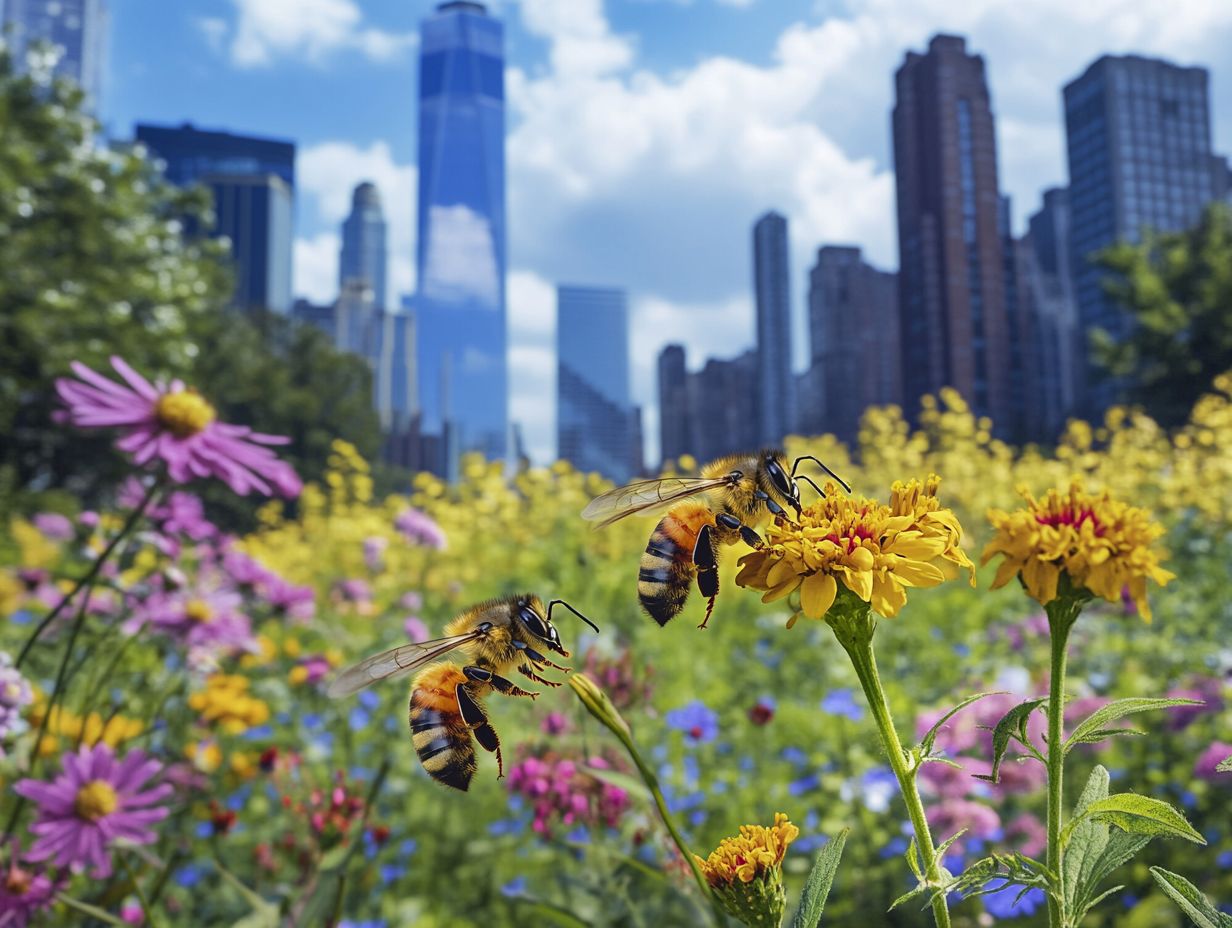
The adaptation of bees to urban environments presents a remarkable array of benefits that go beyond mere survival. By thriving in these bustling settings, bees significantly enhance pollination services, crucial for boosting biodiversity and supporting urban agriculture. This also aids in honey production and other honey-based products, providing economic benefits.
A flourishing bee population opens up unique opportunities for citizen science and educational initiatives, enriching urban ecosystems and fostering a deeper connection between communities and nature. Projects like Amit Godse’s Bee Basket in Pune exemplify community engagement and awareness programs that highlight the importance of bees.
Increase in Pollination and Crop Production
The rise in pollination services provided by bees that adapt to their surroundings links directly to improved crop production in urban environments. This ultimately bolsters food security. Observing these industrious bees effectively pollinating a variety of flowering plants shows their significant contribution to higher yields in urban agriculture and community gardens.
This relationship promotes the growth of resilient crops. It also fosters biodiversity in city ecosystems. As urban centers expand, the role of these vital pollinators becomes even more exciting! With enhanced pollination rates, you ll see the successful cultivation of fruits, vegetables, and nuts essential for local diets.
Thriving bee populations enable local economies. They allow urban farmers to provide fresh produce, ultimately reducing reliance on imported goods. The role of bees goes beyond mere pollination; it lays the foundation for local agricultural sustainability and food security. Resilient bee species such as Apis cerana indica and Melipona irridipennis further support local ecosystems and food supply.
Improved Biodiversity in Cities
The presence of adaptable bee populations in urban environments significantly enhances biodiversity, enriching ecosystems that benefit all native species. This increased biodiversity is vital for maintaining essential ecosystem services like pollination and habitat stability, crucial for sustaining urban landscapes. Bee boxes and other bee-friendly designs promote habitat stability and support ecosystem functionality.
As bees interact with various flowering plants, they facilitate the reproduction of numerous species. They weave a vibrant network that supports wildlife diversity. These small pollinators play a pivotal role in sustaining a wide range of creatures, from birds to beneficial insects, all of which rely on flourishing plant life for food and shelter.
To maximize this ecological impact, it s crucial for communities to act now to protect bee habitats. This includes planting native flowers and reducing pesticide usage. By fostering environments where bees can thrive, urban areas can cultivate richer biodiversity, ultimately contributing to healthier ecosystems.
Opportunities for Citizen Science, Education, and Community Engagement
The adaptability of bees in urban settings presents unique opportunities for engaging in citizen science and educational programs focused on bee conservation. By getting involved in monitoring and supporting local bee populations, you can help others understand the importance of the essential ecological roles that bees fulfill.
Community engagement is key to the success of these programs. Volunteer groups play an important role in fostering greater awareness and appreciation for bees.
Through hands-on activities, workshops, and community gardens, you will gain insights into the vital contributions of bees to pollination and biodiversity. You will also cultivate a sense of stewardship over your local environment.
These programs can inspire you to plant bee-friendly flowers, create habitats, and participate in citizen-led surveys that track the health and diversity of bee populations. This promotes community cohesion and environmental health.
Using technology like mobile apps or social media can help reach more people, amplifying the conservation message and motivating more individuals to take meaningful action. Your involvement is crucial for a sustainable future!
What Can We Do to Help Bees Thrive in Urban Environments?
To help bees flourish in urban settings, you and your community can embrace effective strategies such as cultivating pollinator-friendly gardens. These gardens offer vital habitats and resources for bees and other insects that help plants produce fruits and seeds.
These initiatives not only bolster local bee populations but also foster biodiversity the variety of plants and animals and improve the overall health of urban ecosystems. This is crucial in addressing habitat loss and fragmentation.
Planting Pollinator-Friendly Gardens with Native Flowering Plants
Planting pollinator-friendly gardens in urban spaces is an important step toward nurturing habitats for bees and other pollinators. By integrating a wide variety of flowering plants and native species, you offer crucial resources for these busy little creatures while contributing to the health of local ecosystems.
Native flowering plants like Cassia fistula significantly support local bee populations and biodiversity. This diversity ensures that pollinators can find food sources throughout the growing season, catering to their varying preferences and life cycles.
Consider incorporating perennials like coneflowers, black-eyed Susans, and asters. These blooms appear at different times, providing nectar and pollen that foraging bees crave. Don t overlook herbs like lavender and mint they not only enhance your culinary creations but also attract these essential pollinators. Additionally, planting wildflowers can further boost insect biodiversity.
Focusing on native plants is paramount as they are uniquely suited to local climates and soil conditions. This creates a thriving environment for pollinators and enhances urban biodiversity, which is increasingly important as natural habitats continue to shrink.
Initiatives led by researchers such as K Lakshmi Rao at the Central Bee Research and Training Institute in Mysore, Karnataka, emphasize the significance of native plants.
Reducing Use of Pesticides
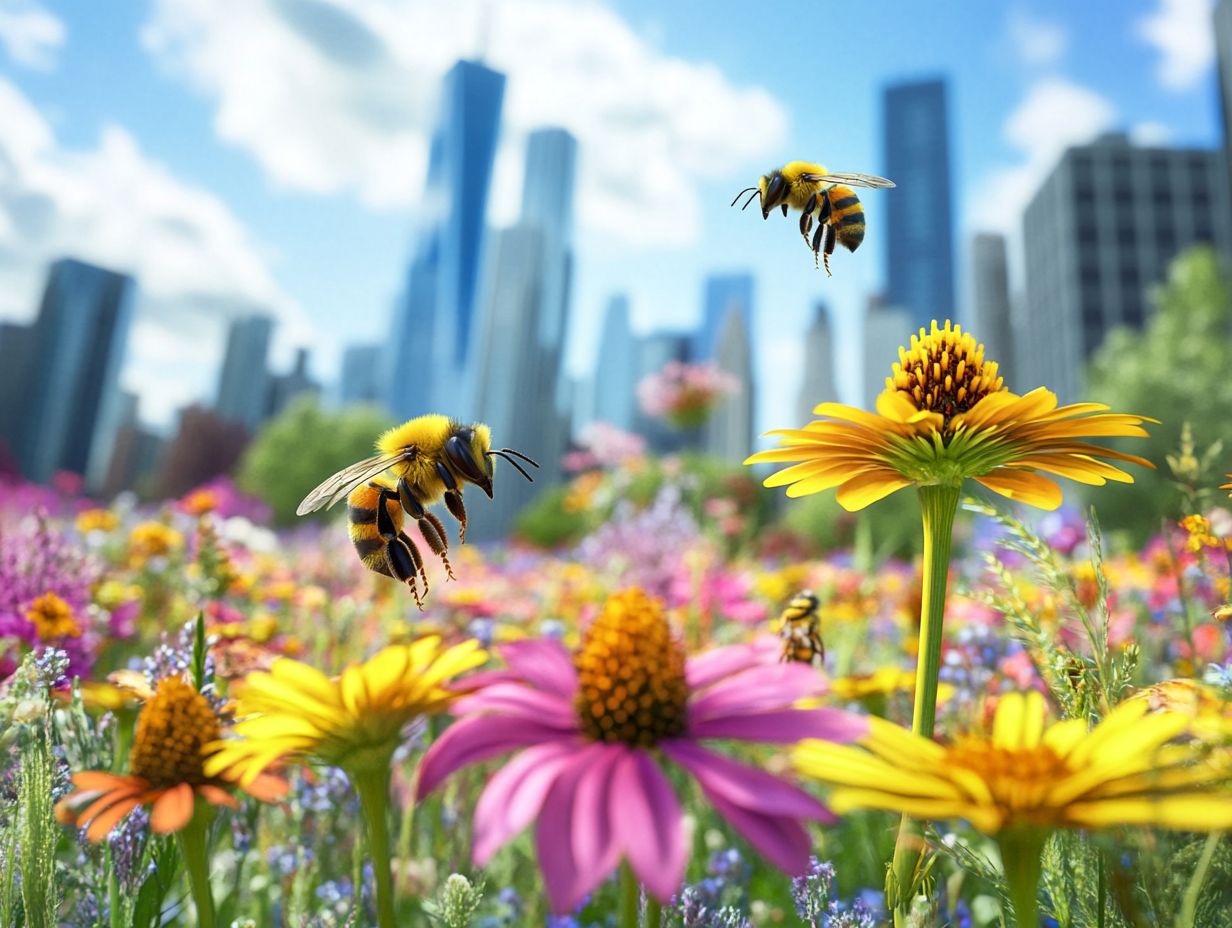
Reducing pesticide use in urban environments is essential for promoting bee health and lessening the impact of environmental toxins on pollinator populations. By championing sustainable pest management practices and cutting back on chemical treatments, you can significantly contribute to the protection of local bee populations. Articles in publications like the Journal of Applied Ecology highlight the detrimental effects of pesticides on bees.
This proactive approach not only preserves the vital roles that bees play in our ecosystems but also encourages the adoption of alternative methods that are kinder to these crucial pollinators. For example, urban gardening initiatives can embrace integrated pest management techniques, such as biological control or botanical pesticides, which offer safer options for maintaining plant health and promoting biodiversity and insect biodiversity.
Local governments and community groups can team up to implement educational campaigns and awareness programs that raise awareness about the importance of bees and the risks associated with pesticide use. By cultivating a culture of bee-friendly gardening and supporting local beekeepers, urban areas can enhance plant biodiversity and foster healthier environments where bees can thrive, free from the dangers of harmful chemicals.
Supporting Local Beekeepers and Bee-Friendly Businesses
Supporting local beekeepers, including those who tend to Apis mellifera and Indian bees, and bee-friendly businesses is an essential step for you to promote sustainable honey production and enhance the health of bee populations in urban areas. By making the conscious choice to purchase from these sources, you contribute to creating a market that prioritizes conservation and environmental wellness. Supporting local beekeepers and encouraging the growth of honey-based products can also improve food security and ecosystem services.
Supporting local beekeepers and bee-friendly businesses is an essential step for you to promote sustainable honey production and enhance the health of bee populations in urban areas. By making the conscious choice to purchase from these sources, you contribute to creating a market that prioritizes conservation and environmental wellness. Supporting local beekeepers and encouraging the growth of honey-based products can also improve food security and ecosystem services.
In doing so, you not only enjoy honey that is fresher and more flavorful but also champion practices that foster biodiversity and strengthen ecosystem resilience. Local beekeepers frequently employ sustainable methods that reduce the use of harmful pesticides and encourage natural foraging, which significantly benefits the urban flora, local fruits, and fauna around you.
Engaging with local businesses deepens your community connections and raises awareness of the vital role bees play in pollination. This active involvement can lead to educational initiatives, workshops, and events that inspire a deeper appreciation for your local environment, ultimately cultivating a culture that respects and nurtures these essential pollinators. These efforts can also support the growth of ecological functions and community engagement.
Frequently Asked Questions
How are bees adapting to urban environments?
Bees are adapting to urban environments in a variety of ways, including changing their foraging habits, building nests in new locations, and developing resistance to pesticides and pollutants. The urbanization and habitat loss caused by expanding cities force bees to adapt to survive.
What changes have bees made in their foraging habits in urban environments?
In urban environments, bees have been observed foraging on a wider variety of plants, including native flowering plants and other species that are not typically found in their natural habitats. They have also been observed foraging at different times of the day in order to avoid competition with other pollinators and cope with the urban heat island effect.
Why are bees building nests in new locations in urban areas?
As their natural habitats disappear due to urbanization, bees seek new places to build nests. They often use man-made structures like buildings, walls, and telephone poles.
Implementing bee-friendly designs in residential areas and city parks provides essential nesting sites.
How are bees developing resistance to pesticides and pollutants in urban environments?
Bees can adapt to certain pesticides and pollutants commonly found in urban areas. They break down harmful substances and, through natural selection, only the strongest bees survive.
This ability helps them cope with environmental toxins and thrive in urban habitats.
Are there any negative impacts of bees adapting to urban environments?
There are benefits to bees adapting to urban environments, including increased pollination of urban gardens and green spaces. However, they also face challenges like increased competition with other pollinators and exposure to more toxins.
Invasive species and habitat fragmentation also make these challenges worse.
What can individuals do to help bees adapt to urban environments?
You can make a difference by creating pollinator-friendly spaces in your yard! Avoid using harmful chemicals and support local beekeeping initiatives.
Planting native flowers and providing nesting sites like bee boxes and pollinator habitats will support urban bee populations.
Engaging in community gardens and volunteer groups also enhances community cohesion and ecological functions.



